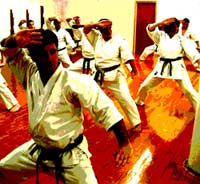Why Kata Is Important
By Jason Armstrong

Too
many karate-ka today relegate kata to a secondary status behind practice
of kumite. This is a mistake. This view, I believe, represents
a profound misunderstanding of kata’s role and purpose.
Kata should instead be the foundation of karate training. Why? Three
Points of discussion:
- Philosophy & Zen
- Relationship to sports karate
- A time chest of advanced self defense techniques for black belts
Kata allows students to share a pool of knowledge which the greatest
karate-ka of the past, and present, have used to study the Way. The kanji
(Chinese character) for kata can be interpreted as a pictograph representing
a bamboo lattice window. Sunlight can shine through such a window leaving
a pattern which is defined by not only light but also the presence of
shade.
This “Yin-Yang” essence in kata is noted in such opposites
as fast/slow, hard/soft & still/movement. For example, at the end
of any given combination in kata the particpent should pause before moving
to the next direction to create
Zanshin (continued alertness) and a Yin/Yang event (i.e. often kata are
rushed, and practitioners do not pause long enough before changing directions – the
pause creates the moment and contrast to movement and speed).
When studying in Japan several of my teachers (including Sotokawa 8th
Dan Shito-ryu, Uetake 7th Dan Shito-ryu and Iba, 8th Dan Shito-ryu) would
emphasize a slow count of 1-2-3 before changing to the next direction,
or set of moves.
Each kata represents an archived library of self defense techniques.
Often the application of each motion within kata is not well understood
within many Japanese karate dojos unless the effort has been made to
dive into the Okinawan and Chinese roots. One should aim to understand
and practice at least one bunkai (breakdown of movements) motion for
each action in a kata (probably no one can know all and be proficient
in all bunkai variants).
Most of the original applications do not involve the basic kicks and
punches which are often given as an interpretation, but rather grabs,
breaks, pressure points and close in fighting. The elaborate nature of
these actions (symbolized by individual kata motions) are challenging
even for black belt ranks to know, practice and execute proficiently.
Once a bunkai is understood it should be drilled with partners (like
drill kumite combinations) at high speed, and in repetition.
Kata demands techniques executed with precision and power. It trains
the body to strike from different stances and different orientations,
as is always the case in kumite. Kata trains one to move quickly, and
to use precise and stable stances for the execution of solid techniques.
Without this ability one will be unable to control an opponent during
battle. Furthermore, if one cannot execute precise and powerful technique
in kata, it will definitely not happen in the heat and chaos of kumite.
Visualization of the opponent for each move is one method of kata development
that can be done as a drill. It helps bring a kata to life accentuating "kime" (focus), "penetration" and "zanshin".
This is one of many training approaches to develop kata, however one
must always remember that when kata is performed in a non-training
sense (i.e. its final form) it should embrace “Mushin” (no
mind, no thought). “Mushin”, a high goal of all martial
artists, allows the mind to be open to all possibilities in the fighting
engagement with no hesitation or change of thought pattern prior to
execution.
As one approaches black belt, kata must begin to feel like it is a true
expression of oneself, presenting all inner and outer attributes. Therefore,
when kata is performed, the presence of “Ki” (internal energy)
and spirit can be felt, something which demands the attention of onlookers.
As kata is practiced year after year, some of the more difficult techniques
and subtleties begin to emerge in one's fighting. This acts as a source
of continual growthfor advanced karate-ka. The integration of techniques
acquired from kata into one's fighting provides a challenge that will
easily fill a lifetime (for example the ashi barai take downs in such
kata as Seipai or Tekki Shodan are directly applicable to modern Sports
Karate and street fighting). It requires both a combination of physical
mastery and the possession of a calm mind amidst the storm of battle.
In seminars we often deliberately make a point that kata has direct
translations to "Sports Karate,"and using examples of strategy
and sometimes technique variants, aids students in understanding this
relationship. Of course not all kata bunkai can be transferred to sports
karate, just selected parts or variants. However, taking students down
this path often helps them understand the need to think about kata
for their longer term karate and fighting growth
About The Author:
Dr. Jason Armstrong, 5th Dan, has been training for more than 20 years.
His training began in Australia, and then he moved to the USA in 1991.
In 1995 he began regular travel to Japan and spent time living in Japan
for karate. While in Japan he worked in the corporate environment and
ultimately became the CEO of a company in Tokyo. He holds a Ph.D. in
human physiology. Today he has founded Applied Zen, which operates in
the USA and Australia passing on Japanese karate through dojos and through
a video e-learning site (www.DownloadKarate.com). Additionally, his organization
provides corporate seminars on the integration of Budo Strategy, the “Art
of War”, and Zen into the corporate world and business.
|